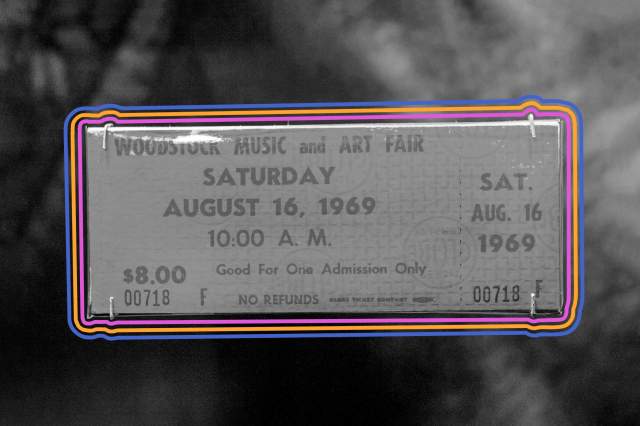
No Town Wanted to Host the Festival
Woodstock’s organizers — Miami Music Festival alum Michael Lang, Capitol Records executive Artie Kornfeld, and entrepreneurs John Roberts and Joel Rosenman — searched various upstate New York locations, originally trying to put the event in the town of Woodstock and then the town of Saugerties before settling on the town of Wallkill. But residents objected, and the board passed an ordinance prohibiting gatherings over 5,000 people and then officially banning the festival on July 15, leaving the organizers scrambling to find a new venue just weeks before the event.

A Dairy Farm Was Rented Out for the Event
Sullivan County dairy farmer Max Yasgur stepped in and rented out his 600-acre farm for the event. “I never expected this festival to be this big,” he said at the time. “But if the generation gap is to be closed, we older people have to do more than we have done.” Yasgur, who died in 1973 at the age of 53, put the property — located in Bethel, about 60 miles from Woodstock — up for sale in 1971. He’s also remembered for stepping in and providing milk, cheese, and butter when the festival ran out of food, as well as free water, while others had been charging for it. “How can anyone ask for money for water?” Yasgur said at the time.

The Festival Was Free — But Wasn’t Meant To Be
About 100,000 tickets ranging from $6 for a day to $18 for the weekend had been sold ahead of time, but so many people arrived early that organizers didn’t have time to build the ticket booths, among other things. “You do everything you can to get the gates and the fences finished, but you have your priorities,” Lang told The Telegraph. “People are coming, and you need to be able to feed them, and take care of them, and give them a show. So you have to prioritize.”
More Interesting Reads

Creedence Clearwater Revival Was the First Band to Sign On
The legendary lineup of 32 acts who played in addition to Hendrix included Joan Baez, Santana, The Grateful Dead, The Who, Janis Joplin, and Crosby, Stills, Nash & Young. But the first one to officially sign on was Creedence Clearwater Revival. “Once Creedence signed, everyone else jumped in line and all the other big acts came on,” the band's drummer Doug Clifford said. “The next acts to sign on the dotted line were Jefferson Airplane, Joe Cocker, and Ten Years After.”

Some of Music’s Biggest Names Passed on Woodstock
Not all musicians were eager to join the festival, including The Beatles, The Doors, Bob Dylan, Led Zeppelin, The Rolling Stones, and Joni Mitchell. Scheduling conflicts were the culprit for Zeppelin (they played in New Jersey’s Asbury Park that weekend) and The Stones (frontman Mick Jagger was shooting a movie in Australia), while, unbeknownst at the time, John Lennon was about to quit The Beatles the following month. As for The Doors? “We were stupid and turned it down,” guitarist Robby Krieger later admitted.

A Young Martin Scorsese Helped Direct a Woodstock Documentary
Just a few days before the concert, Lang and Kornfeld made a deal with director Michael Wadleigh to film a documentary. Among the team that Wadleigh — who had followed President Richard Nixon on his campaign trail in 1968 — put together was recent NYU film school graduate Martin Scorsese as the assistant director. “At one point, Marty tried to take a nap in a pup tent under the stage,” cameraman Hart Perry told Rolling Stone. “He knocked over the pole, and the whole thing collapsed. He had claustrophobia and was screaming for somebody to help him. But he wasn’t Martin Scorsese yet, he was just some schmuck from Little Italy.” The Warner Bros. documentary — simply titled Woodstock — went on to win the Oscar for Best Documentary Feature.

The U.S. Army Was Called in to Keep the Peace
Few police officers were assigned to Woodstock, but when the masses started descending early, organizers thought it could turn into one of “greatest human tragedies in modern times,” so a combination of local authorities, health care professionals, and the U.S. Army were gathered to step in. Also part of the contingency was the Hog Farm, a New Mexico-based hippie commune led by Hugh Romney, who was better known as Wavy Gravy. Among their strategies to help keep the peace was to threaten those causing trouble by dousing soda water or throwing custard pies. But they also ended up stepping in and helped cook and serve food.

The Sound System Was Advanced for Its Time
An unexpected aspect the festival was noted for was its sound system, despite the outside setting. Audio engineer Bill Hanley came up with a method that took advantage of the shape of the field. “We built two speaker towers, each of which had two levels containing its own speaker cluster,” he told Front of House Magazine. “The dense crowd conveniently absorbed some of the sound.” Now known as the “Woodstock Sound System,” it was “the largest, most advanced, and expensive concert sound system ever constructed” because of its “quality, clarity, and intelligibility,” according to the mag.

The Grateful Dead's Set Was Problematic
Mother Nature unleashed her own excitement, pouring rain on the outdoor festivities, particularly when The Grateful Dead took the stage on Saturday night — and an internal delay didn’t help either. “It was raining toads when we played,” guitarist Bob Weir told Rolling Stone. “The rain was part of our nightmare. The other part was our sound man, who decided that the ground situation on the stage was all wrong. It took him about two hours to change it, which held up the show.” By the time they played, the mix proved to be dangerous. “Touching my guitar and the microphone was nearly fatal,” Weir said. “There was a great big blue spark about the size of a baseball, and I got lifted off my feet and sent back eight or 10 feet to my amplifier."

Joni Mitchell Wasn’t Actually at Woodstock
Joni Mitchell may be known for her song “Woodstock,” with lyrics like “By the time we got to Woodstock / We were half a million strong,” but she didn’t actually attend. Originally on the Sunday lineup, she had a TV appearance in New York City on Monday and her team was afraid she wouldn’t make it back in time. She wrote the tune in a New York City hotel room based on what fellow singer-songwriter Graham Nash, who she was dating at the time, told her as well as footage she saw; she performed it at the Big Sur Folk Festival later that year. Crosby, Stills, Nash & Young went on to release a version of Mitchell’s song.











